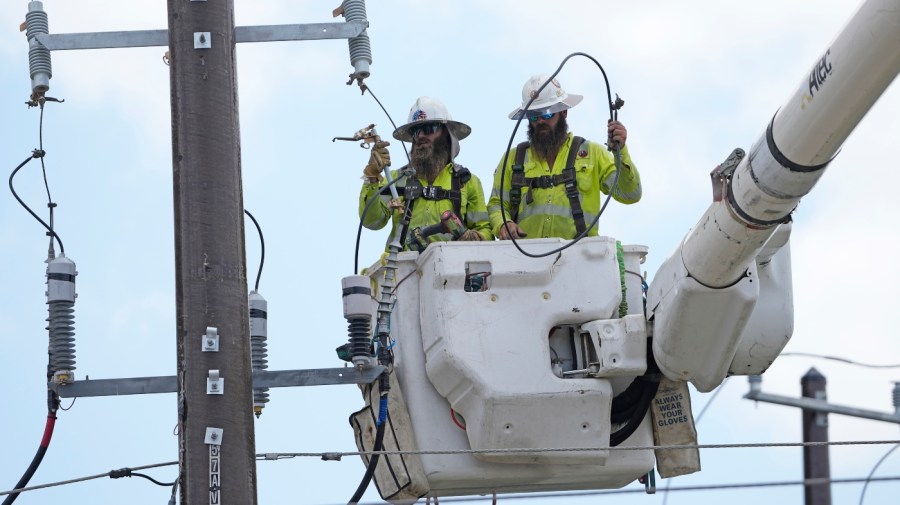The , which recently celebrated its first birthday, is building momentum toward our nation’s clean energy future. Unfortunately, our existing transmission system limitations threaten to undermine the law’s clean energy potential. Thankfully, new technologies are poised to release the chokehold by enabling our existing grid to accommodate substantial capacity increases, allowing for the integration of additional renewable generation.
The act is driving record investments in the deployment of new renewable generation, so much so that new wind and solar projects are facing challenges plugging into the grid as operators work to ensure that added power can move along transmission lines. The need for additional transmission capacity to ensure that we can both connect more clean energy and ensure existing renewable generation isn’t curtailed due to transmission congestion is obvious. According to of the Biden administration’s ambitions to transition the electric grid to net zero by 2035, transmission capacity will need to increase by more than 100 percent of its current network to match climate and renewable energy goals.
That number will likely grow as additional transportation, building and industrial electrification technologies come online. If the grid’s transmission infrastructure does not grow quickly enough, the United States could delay for years as much as 80 percent of the emission reductions projected from the passage of the Inflation Reduction Act, according to . Making matters worse is — including wildfires, flooding and storms — which further strain the grid.
How quickly grid operators and utilities can deploy additional transmission capacity is a multifaceted challenge. Permitting and construction timelines for even the shortest transmission projects are measured in years; more ambitious, multi-state projects can take a decade or longer, with a high chance of never even getting built — all at a cost in the billions of dollars. In other words, much-needed short-term transmission buildouts may not be ready until the late 2030s, even as key Biden administration officials and Capitol Hill lawmakers recognize the need to move faster.
Luckily, existing technology can help bridge the timeline gap. Utilities now have a range of tools at their disposal known as grid enhancing technologies, which can enable more energy to flow along existing networks. One such technology, dynamic line ratings, has been proven to bolster transmission capacity by compared to current levels — a significant jump that can help the grid right now unlock more clean energy resources to help meet the growing demands to electrify everything from transportation to home appliances.
Full disclosure: I serve on the board of LineVision Inc. , a company that specializes in dynamic line ratings. Grid-enhancing technology deployment timelines are measured in months, not years, at costs 1/20th of the price of new transmission line buildouts.
Installation can also occur while transmission lines remain operational. Dynamic line rating has the added benefit of monitoring transmission infrastructure to ensure efficiency and reliability amid extreme weather events like heat waves or hurricanes or extreme cold snaps like the Texas storm of 2021 that resulted in an estimated in economic losses. The grid’s transmission needs will require an all-hands-on-deck approach, including new transmission lines and upgrades to existing infrastructure, in addition to the deployment of more grid enhancing technologies.
But amid the broader debate on Capitol Hill on permitting and the ambitions to deploy more transmission infrastructure on the grid, Congress and the Biden administration have the opportunity to embrace policies that promote the use of grid enhancing technologies at a time when we all are seeking cost-effective and reliable climate solutions. The Federal Energy Regulatory Commission (FERC) leadership is key. The commission took an initial step last month with , which finalized a long-awaited rulemaking to streamline the interconnection process for new generations.
But this order does nothing to align incentives for utilities to accelerate the adoption of grid enhancing technologies. FERC can remedy that by following through with a notice of inquiry on dynamic line ratings, . A key Inflation Reduction Act learning lesson for FERC to consider is that carrots work better than sticks.
Congress can bolster FERC’s efforts through legislative action to encourage grid enhancing technologies as part of its broader debate on permitting. Key negotiators of a permitting package in both the House and Senate talks on finding common ground on the issue remain in play, and any additional hearings on the topic present a perfect opportunity for closer examination of grid enhancing technologies as part of the solution to the nation’s transmission challenges. At the one year mark, the Inflation Reduction Act is off to a good start, but it is headed into a roadblock without swift action to expand grid capacity.
The time is now to remove that roadblock through policies that elevate and promote grid enhancing technologies as the low-hanging fruit of a needed transmission buildout. .
From: thehill
URL: https://thehill.com/opinion/energy-environment/4171124-technologies-to-enhance-the-power-grid-exist-we-just-need-to-deploy-them/



